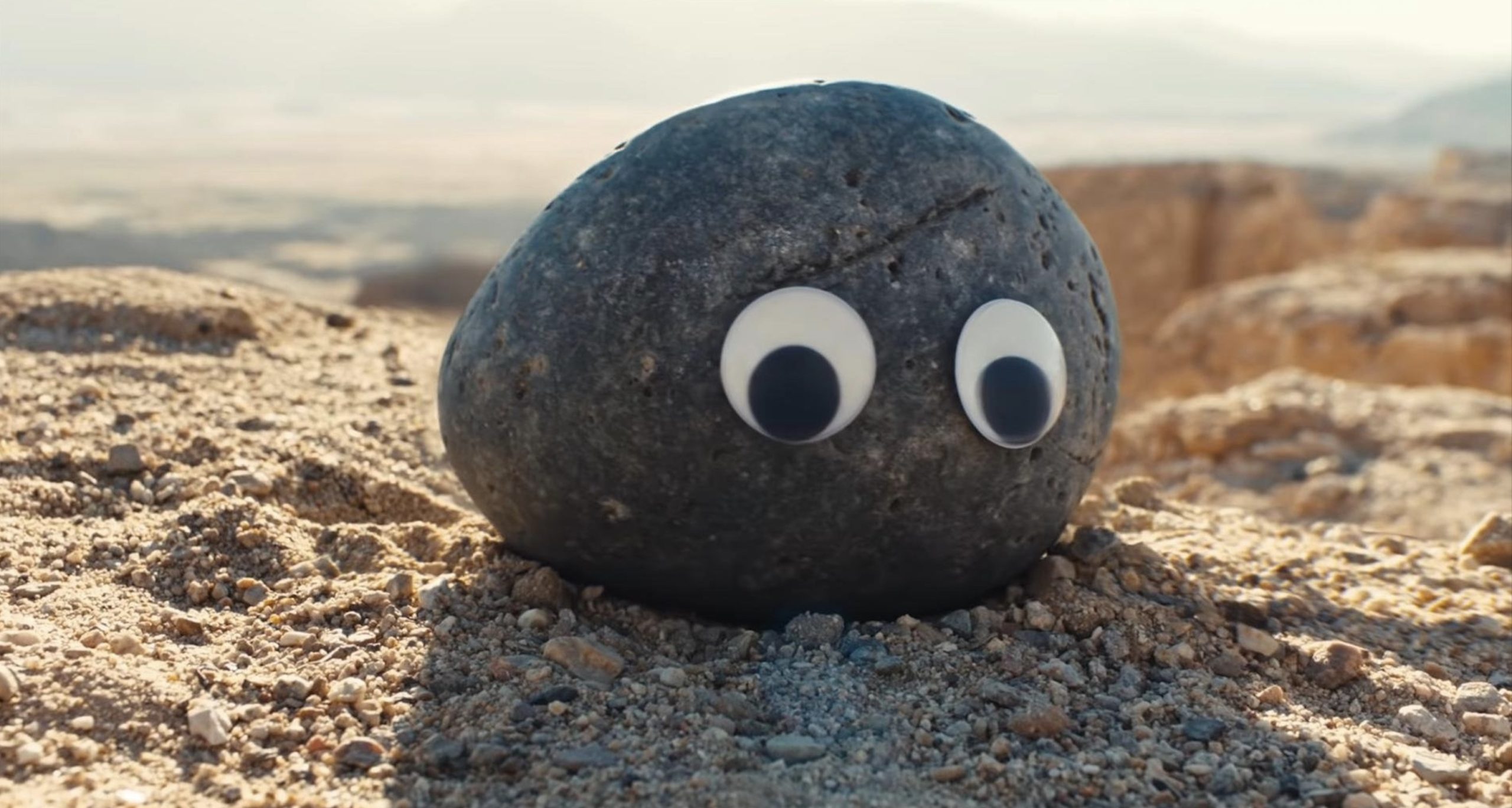Table of Contents Show
Caution! This article contains spoilers for Everything Everywhere All At Once.
Post the height of COVID-19, things still feel off — things being, everything. It’s impossible to return to “how things were” before the pandemic started. Attention spans are shortened, social cues are upset, and the lingering thought of “ugh, what’s the point?” is frequent. Daniel Kwan and Daniel Scheinert’s Everything Everywhere All At Once (2022) grabs these feelings of monotony, and the untouched “what-ifs” of life without COVID, by the reins and drags the viewer along for the chaotic ride. Utterly ridiculous and unpretentiously profound, Everything Everywhere is a love letter to finding meaning in times that feel meaningless.
Everything Everywhere All At Once (2022): Synopsis
The film follows Evelyn Wang (Michelle Yeoh), a woman who left China back in her youth with her first love despite her parents’ disapproval. Now, in America, Evelyn owns the laundromat under her apartment with her even-tempered husband, Waymond (Ke Huy Quan). The viewer is immediately thrown into the frantic chaos of Evelyn’s life. She is the definition of “overwhelmed” as she runs about trying to arrange a Chinese New Year Party for her customers while also preparing for her traditional, estranged father to arrive on the same day their laundromat is being audited by the IRS. On top of that, her daughter, Joy (Stephaine Hsu), wants to introduce her girlfriend to her grandfather despite Evelyn’s unease towards Joy’s youthful angst and sexuality.
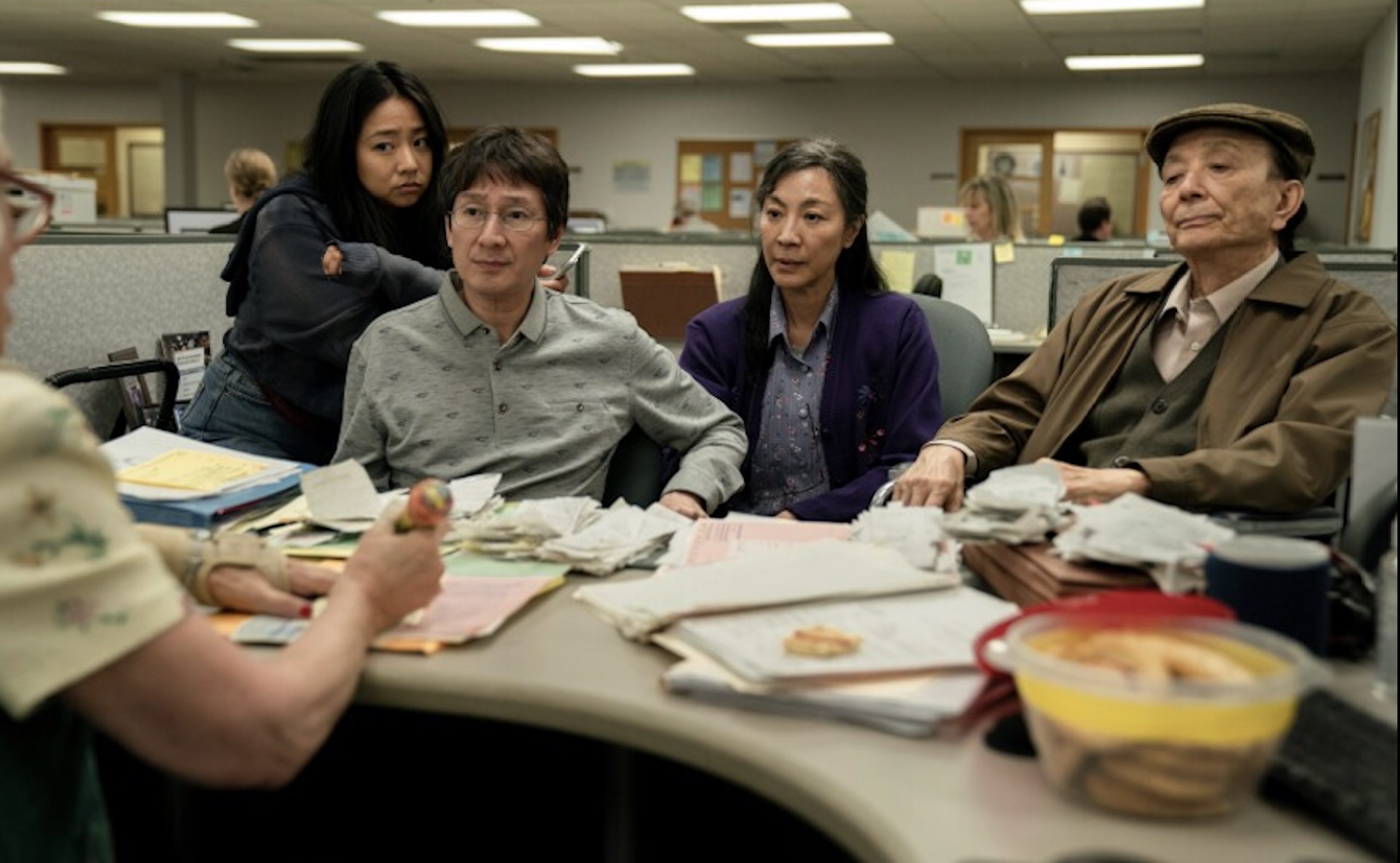
It’s difficult to say more about the plot of the film. Words cannot substitute for the experience that is Everything Everywhere All At Once. It’s whimsical, humorous, and melancholy in a way that should not work, but does. It’s exhausting. It’s exhilarating. It’s clever and so deeply sincere. Yes, the action is over-the-top, and it’s hard to pinpoint a moment in the film where one can catch their breath as they follow Evelyn through the multiverse. At its heart, however, none of that really matters. The essence of the story is found in a bittersweet tale of a family choosing their people. Family and life are complicated, but one can always choose to take care of each other; to be kind to one another. This is no easy task to convey, but Everything Everywhere is a guiding hand – even if the hand has its fun spinning the viewer around a bit first.
Part I: The Chaos
While the film’s message is simplistic – take care of each other, be kind to one another — its execution is anything but. Daniel Kwan and Daniel Scheinert, known as the filmmaking duo ‘The Daniels,’ are not afraid to play into the chaos that a film about the multiverse demands. Everything Everywhere is risky. It is asking a lot of the audience to buckle up and trust the ride, but that’s also where the film’s strength lies — in completely surrendering to itself.
On The Multiverse
There is so much constantly happening, and never before in the history of the world has there been a time where there is such quick access to news; a continuous streamline of information at one’s fingertips, 24/7. It’s a recipe for a breakdown. Everything Everywhere highlights this dissonance, using the multiverse as a metaphor for the internet and the heightened state of online activity that resulted from the pandemic. With access to endless information and a constant cacophony of stimuli, traveling through universes with Evelyn is reminiscent of scrolling through feed after feed with no time to stop and reflect. It is a journey of whiplash.
Such chaos is overtly reflected in the film’s use of the multiverse. This concept of parallel realities is not a new one. It has been used in comic books for decades, found in an episode or two of Supernatural (2005-2020), and recently been popularized in the mainstream thanks to Spider-Man: No Way Home (2021; Jon Watts) and the Marvel Cinematic Universe. Everything Everywhere takes this frenzied idea and offers viewers a fresh take.
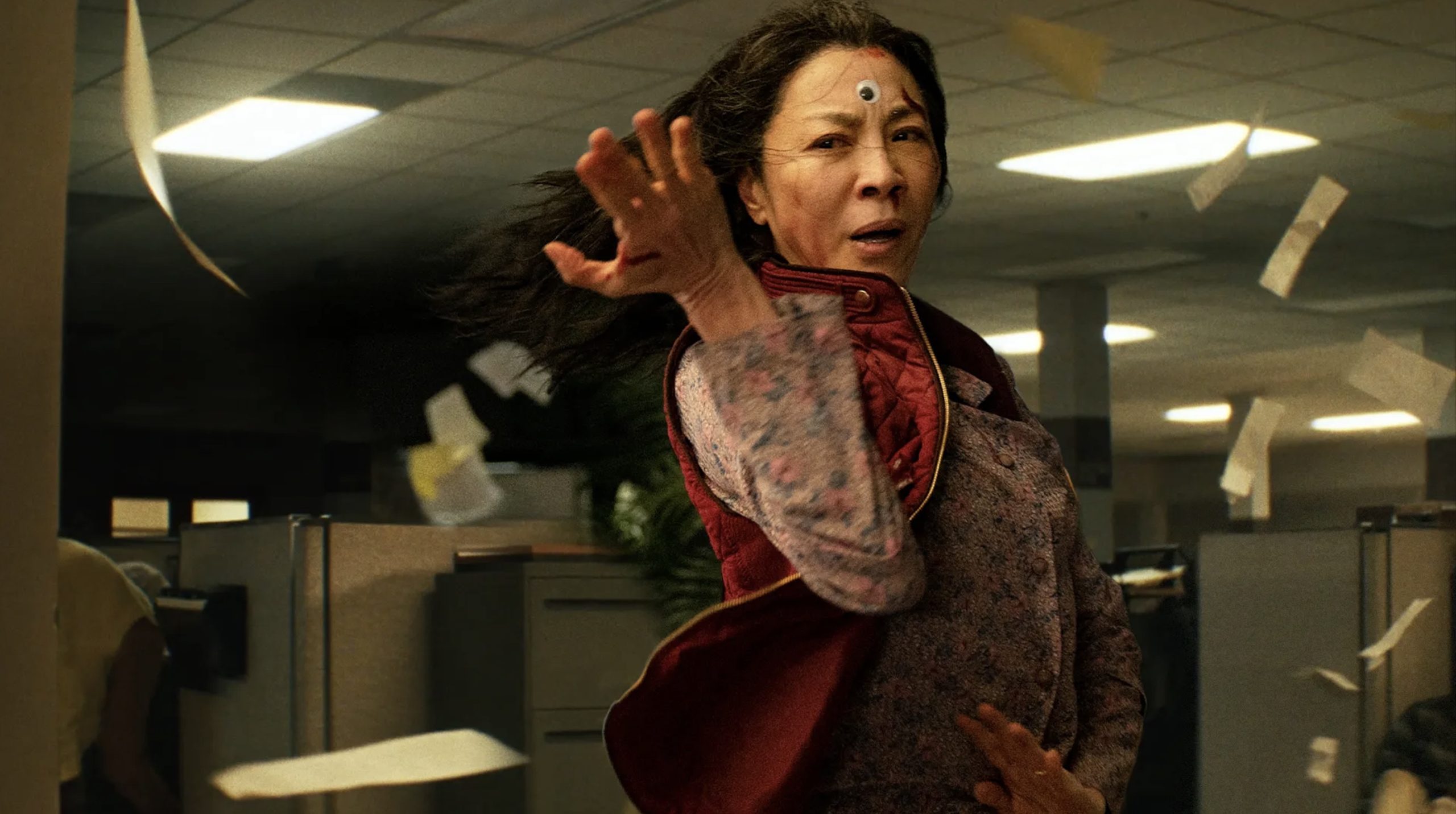
Evelyn travels through Everything Everywhere’s multiverse using a method called “verse-jumping” — something made possible by completing random, often disturbing, acts such as eating chapstick or snorting a fly. One of Evelyn’s multiverse counterparts created this technology so the people in her universe could access abilities from their other selves in parallel universes. This allows Evelyn, and the viewers, a glimpse into the endless versions of Evelyn. In one, she is a famous opera singer. In another, she is a cook at a restaurant in the universe of “racca-cooney” – a world constructed around the idea of Eveyln misremembering the movie title Ratatouille (2007; Brad Bird).
As Evelyn “verse-jumps” the viewer indulges in snippets of the different, often absurd, universes. With nods to Lilly and Lana Wachowski’s The Matrix (1999), Stanley Kubrick’s 2001: A Space Odyssey (1968), Quentin Tarantino’s Kill Bill (2003), Wong Kar-wai’s In The Mood For Love (2000), and Chungking Express (1994) (to name a few), the Daniels’ take on Everything Everywhere with confident ambition and love for the movies. The duo stuffs their film full of references and homages to other cinematic works, an act incredibly satisfying for those who know their filmography, and something that only makes sense in a film about literally everything. In this way, Everything Everywhere pays its respects while also creating something uniquely its own.
On Identity
In her introduction to her collection of essays on film, Bell Hooks (who goes by “bell hooks”) writes:
“The real truth is that most people find it very difficult to journey away from familiar and fixed boundaries, particularly class locations. In this age of mixing and hybridity, popular culture, particularly the world of movies, constitutes a new frontier providing a sense of movement, of pulling away from the familiar and journeying into and beyond the world of the other.”
(( hooks, bell. Reel to Real: Race, Sex, and Class at the movies. New York, NY: Routledge, 1996. ))
That is to say, film can take one past their limitations of “comfort zone” to create an empathetic kinship in a way words cannot always achieve. This poignant excerpt reflects such notions of identity as commented on in the film. hooks wrote that movies are a bridge that allows border crossing on topics of race, class, and gender. Everything Everywhere, then, acts as a bridge. The film quite literally throws the audience into a “new frontier…pulling away from the familiar and journeying into and beyond the world of the other.” It tugs the viewer away from everything they think they know and feel comfortable with and upends it.
On Meta Narratives
Everything Everywhere encourages this self-reflective, meta experience. In the world where Evelyn is a famous actress (wink, wink) she sifts through her this universe’s memories and a brief moment of Yeoh on the red carpet for Crazy Rich Asians (2018; Jon M. Chu) flashes through her mind. The Daniels were highly conscious of what they were doing, saying, “the subtext of it is that every immigrant woman that you see on the street could be a superstar in our universe.” (( Kwan, Daniel. “‘Everything Everywhere All At Once’ explained: hot dog hands, empathy challenges and meaning in the absurd.” Interviewed by Jen Yamato. Los Angeles Times. 14 April 2022. )) Similarly, casting Quan unlocks a subconscious nostalgia for many viewers. Former child star in Steven Spielberg’s Indiana Jones and the Temple of Doom (1984) and Richard Donner’s The Goonies (1985), Quan quit acting, despite his early success, and switched to a career behind the scenes. He even went on to work with renowned director, Wong Kar-wai.
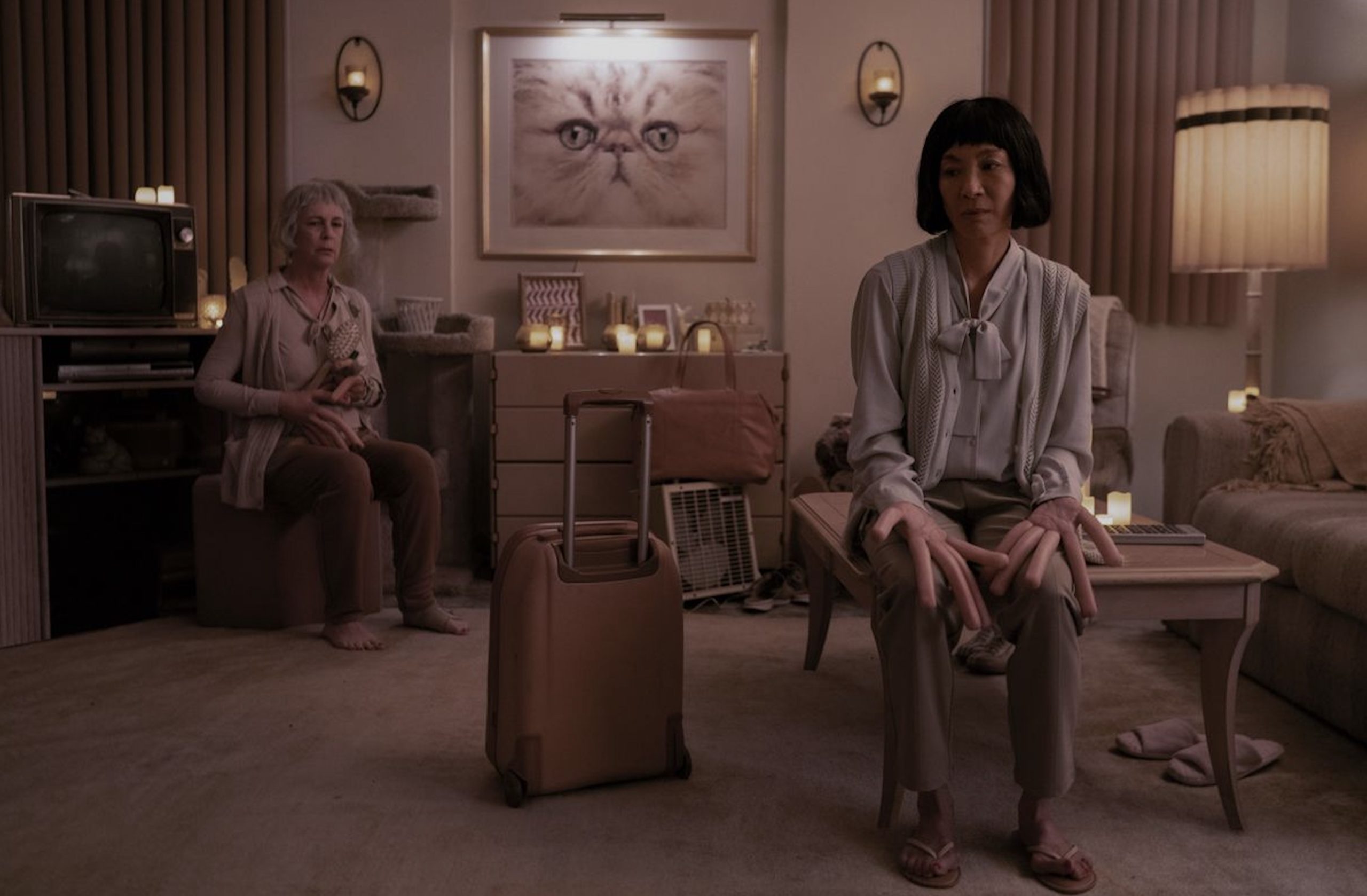
Using clips of Yeoh from the red carpet is a smashing fourth wall break to remind viewers that they are watching a movie, actively. This happens again when “THE END” flashes across the screen as the credits start to roll…for the movie-within-the movie. A silly, apprehensive moment such as this heightens the viewer’s discomfort by forcing them to acknowledge their willing participation in the voyeuristic activity of watching a film. Additionally, it encourages one to contemplate their own multiverse-selves because, in this one, they are sitting in a movie theater watching Everything Everywhere All At Once, but in another, they could be climbing Everest. Perhaps another’s at brunch with their friends; another living under the stars of a different solar system. Maybe another is out there, one so lucky to have never heard the word “quarantine” so much in their life.
Part II: Nothing Matters, Everything Matters
A movie about many things – loneliness, struggling with identity, forgiveness – Everything Everywhere is a work that exceeds any boundary or binary. At the same time, it provides a unique insight into the immigrant experience and generational gaps that go beyond just age; something many will understand and relate to, and something many will not. But, one does not need to have the same experience as another to resonate with the themes of the film. Exclusivity cannot effectively coincide in a narrative on the multiverse.
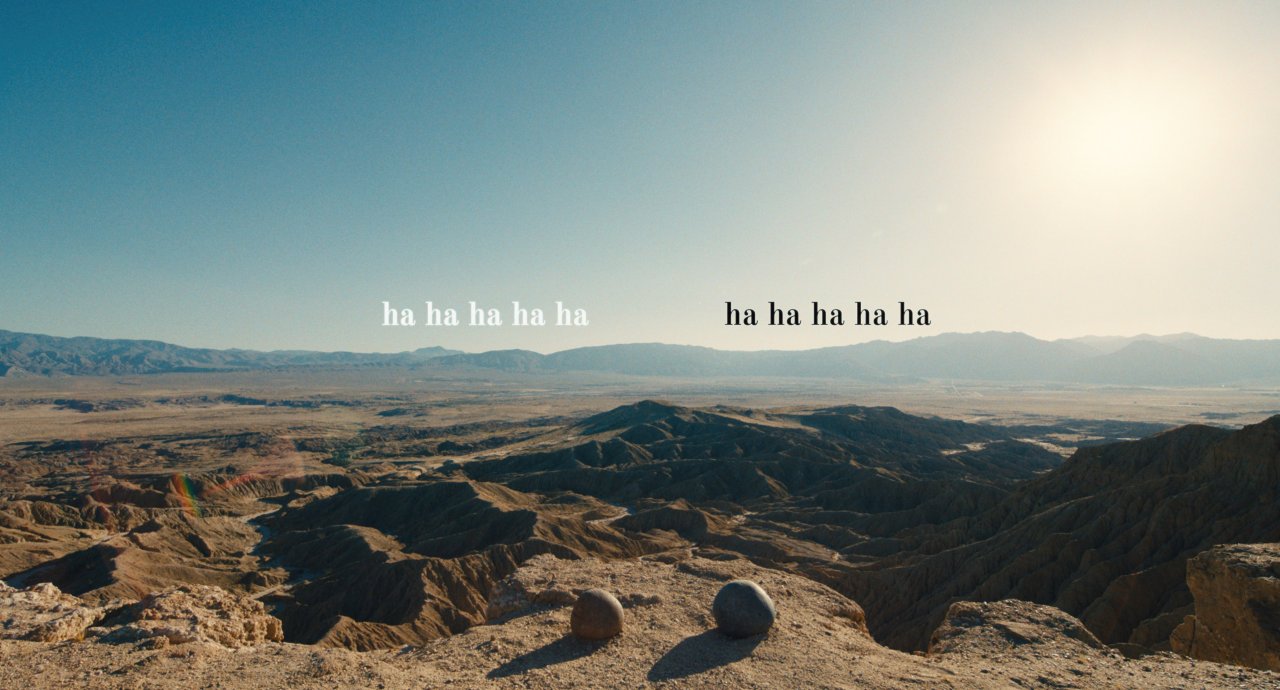
If one can walk away from this movie feeling a little more empathic than they did walking into the theater, a little more appreciative of the people in their life, well, that is quite the win. Sure, maybe nothing matters, but nothing matters. All that glitters is not gold. The grass is never greener. Whichever saying one uses, the message prevails: things could always be different, and sometimes it’s easier to pretend not to care, but it is certainly not as sustaining or fulfilling as being brave enough to try.
Managing to capture all this, Everything Everywhere is not just a visual attack, but a film that brings one from hysterical laughter to teary-eyed sniffles. Daniel Kwan voices:
“When you stare at something for long enough, you can make anything meaningful. That’s a desperate, dangerous thing, but it’s also really beautiful. We need that right now because everyone is staring at everything and seeing no meaning at all. This movie’s almost us trying to fight that by saying, ‘Look, rocks can make you cry!’ There’s beauty and meaning in everything. It can be butt plug trophies. It can be a family drama in a laundromat. We’re putting them all on the same plane. There is no lowbrow or highbrow. It all exists and we have to be ok with that.”
(( Kwan, Daniel. “‘Everything Everywhere All At Once’ explained: hot dog hands, empathy challenges and meaning in the absurd.” Interviewed by Jen Yamato. Los Angeles Times. 14 April 2022. ))
Nothing matters. Everything matters. This film is a cry of joy that pushes against the blasé, nihilistic mindset that too many have fallen victim to. It manages to take a film that questions a reality in which humans have hot dogs instead of fingers and somehow accomplishes by balancing itself with a fervent invocation to be kind in a time so uncaring. It tackles the question of, “what it means to be kind right now, rather than looking at kindness as an abstract principle.” (( Hoeffner, Joe. “How ‘Everything Everywhere All At Once’ Earns Its Kindness and Optimism.” Collider. 27 April 2022. )) In one of the most touching moments of the film, Waymond, from another universe, tells Evelyn, “In another life, I would have really liked just doing laundry and taxes with you.” (( Kwan, Daniel and Daniel Scheinert, directors. Everything Everywhere All At Once. A24, 2022. )) And isn’t that truly what life is all about; finding your people in every universe, no matter the grandeur of it all?
Caring Is Cool
Caring is, of course, not a new idea to intone in popular culture. There are plenty of narratives that ask one to appreciate those around them, whether that be in a song, a television show, a podcast, or another piece of media. Everything Everywhere is a love letter to trying and a triumphant shout of compassion and tenderness. “Take care of you and yours,” (( Dacus, Lucy. “Yours & Mine.” Historians, Matador Records, 2018. Spotify. )) Lucy Dacus sings. “Hold on to each other,” (( Welch, Florence. “June.” High As Hope, Republic Records and Virgin EMI Records, 2018. Spotify. )) Florence Welch sings. Be brave enough to give a damn, Everything Everywhere All At Once, sings. Even in — especially in — times like these.
